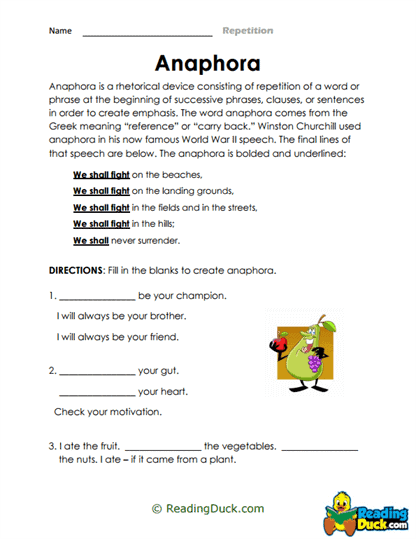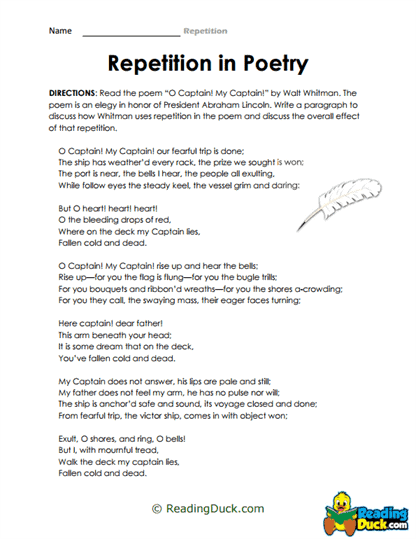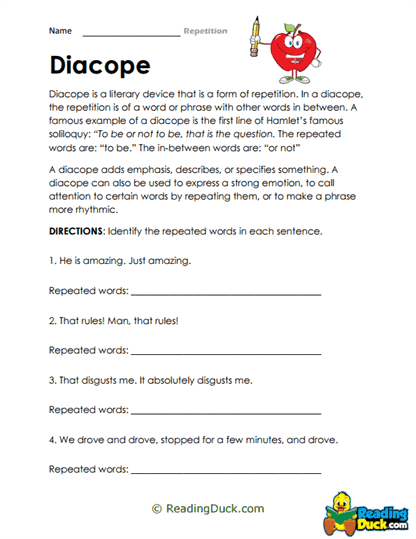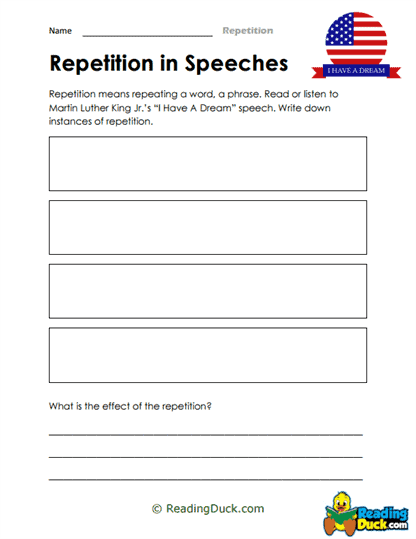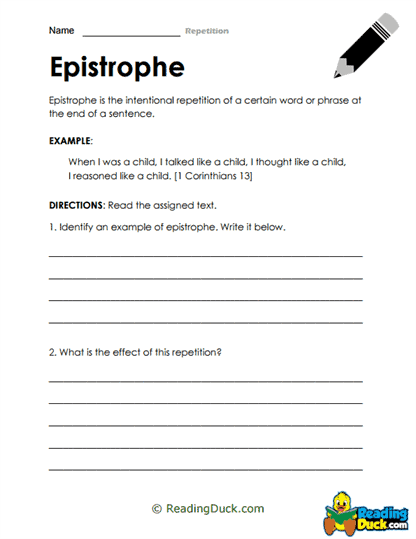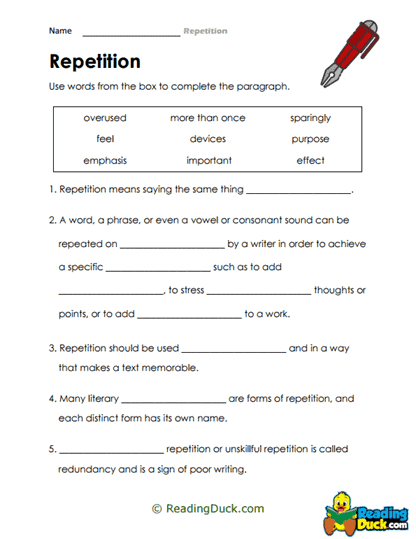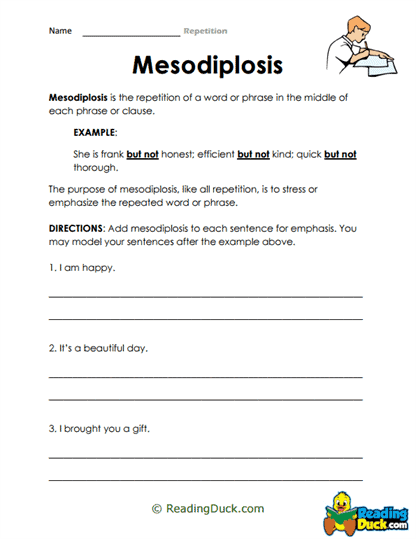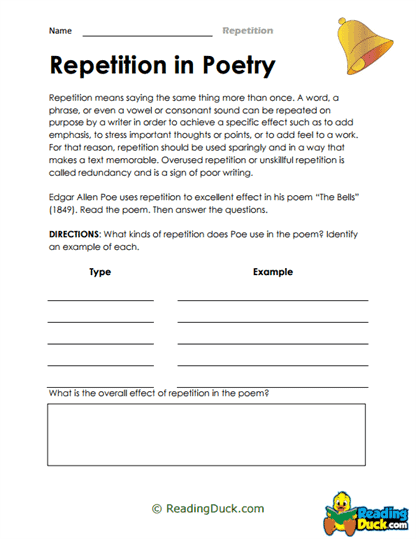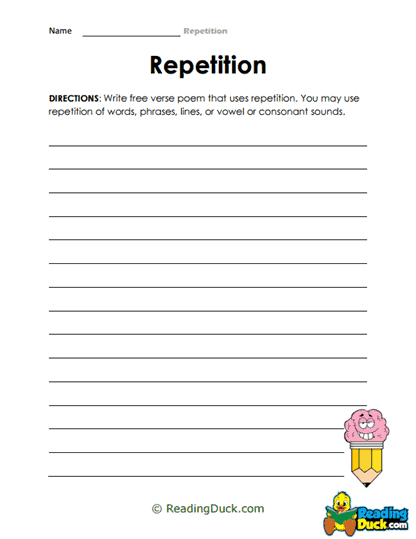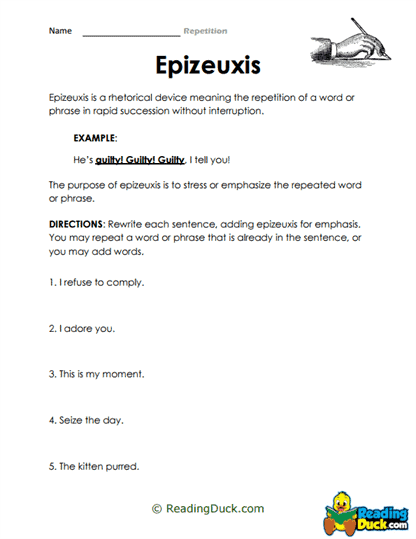Repetition Worksheets
About Our Repetition Worksheets
Our Repetition Worksheets collection is an invaluable resource designed to help students grasp the concept of repetition as a literary device. This collection is part of the Literary Devices category within the Skills section, and it focuses on enhancing students' understanding and application of repetition in both reading and writing. Repetition is a powerful tool used by writers to emphasize ideas, create rhythm, and enhance the emotional impact of their work. Through these worksheets, students will learn to identify different forms of repetition, understand its purpose, and explore how it contributes to the overall meaning of a text.
The worksheets are carefully structured to guide students through various aspects of repetition, from recognizing repeated words or phrases in a text to analyzing how repetition influences the tone and mood of a literary piece. These worksheets serve as a practical foundation for students to not only recognize repetition in the works they read but also to effectively employ it in their own writing.
Presented in a convenient PDF format, the worksheets are easy to view, download, and print, making them accessible for both classroom and home use. Additionally, each worksheet is accompanied by a downloadable answer key, allowing students to check their work and enabling educators to facilitate guided discussions and learning.
Unpacking the Concept of Repetition in Literature
Repetition, as a literary device, is a technique where words, phrases, or structures are repeated to create emphasis, rhythm, or a sense of cohesion in a text. It is a versatile tool that can be found in various forms of writing, from poetry and prose to speeches and everyday communication. Understanding repetition is crucial for students as it not only helps them appreciate the stylistic choices of authors but also enables them to use language more effectively in their own work.
What is Repetition?
Repetition is the deliberate reuse of a word, phrase, sentence, or structure within a text. It serves multiple purposes, such as reinforcing an idea, creating a particular rhythm, or evoking an emotional response. Repetition can occur at different levels within a text—whether it's the repetition of sounds, words, phrases, or entire sentences—and each type can serve a different function.
Types of Repetition
- Anaphora: The repetition of a word or phrase at the beginning of successive clauses or sentences. For example, in Martin Luther King Jr.'s famous speech, the phrase "I have a dream" is repeated to emphasize the vision he had for a better future.
- Epiphora: The repetition of a word or phrase at the end of successive clauses or sentences. This can create a strong sense of conclusion or emphasis, as seen in the phrase "See no evil, hear no evil, speak no evil."
- Epizeuxis: The immediate repetition of a word or phrase with no intervening words. This type of repetition is often used to convey strong emotion, such as in the famous line from Shakespeare's Macbeth: "Out, out, brief candle!"
- Chiasmus: A rhetorical or literary figure in which words, grammatical constructions, or concepts are repeated in reverse order. For example, John F. Kennedy's statement "Ask not what your country can do for you—ask what you can do for your country" is a classic example of chiasmus.
Examples of Repetition in Literature
- "The Raven" by Edgar Allan Poe: The word "nevermore" is repeated throughout the poem, contributing to its melancholic and haunting tone.
- "Do not go gentle into that good night" by Dylan Thomas: The repetition of the phrase "rage, rage against the dying of the light" emphasizes the poem’s theme of defiance against death.
The Role and Origins of Repetition as a Literary Device
Repetition as a literary device has deep roots in the history of storytelling and rhetoric. Its use can be traced back to ancient oral traditions, where repetition was a key tool for memorization and emphasis. Over time, repetition has evolved into a sophisticated device employed by writers across genres to enhance the aesthetic and rhetorical power of their work.
Historical Background
- Oral Traditions: In ancient times, before the advent of written language, repetition was used extensively in oral storytelling. Repeated phrases and structures helped storytellers remember the narrative and ensured that important messages were conveyed effectively to the audience.
- Classical Rhetoric: Greek and Roman orators like Cicero and Demosthenes used repetition to persuade and influence their audiences. The repetition of key ideas helped to reinforce arguments and make speeches more memorable.
- Literary Evolution: As written literature developed, authors began to use repetition not only for emphasis but also for artistic effect. From the refrains in medieval poetry to the modernist experimentation with repeated motifs, repetition has remained a vital tool in the writer’s arsenal.
Defining Characteristics of Repetition
- Emphasis: One of the primary functions of repetition is to emphasize a particular idea or theme. By repeating certain words or phrases, a writer can draw the reader's attention to what is most important in the text.
- Rhythm and Musicality: Repetition can create a sense of rhythm and musicality in writing, making the text more engaging and pleasurable to read. This is especially true in poetry, where repetition often contributes to the poem's meter and overall sound.
- Emotional Impact: Repetition can heighten the emotional impact of a text. For instance, the repeated use of a word like "nevermore" in Poe’s "The Raven" reinforces the narrator’s sense of despair and hopelessness.
The Significance of Repetition in Early Literacy
Repetition plays a crucial role in developing early literacy skills, particularly for young learners who are just beginning to explore language and its nuances. It is a powerful tool that helps children understand language patterns, recognize words, and build confidence in reading and writing.
Enhancing Language Recognition
For young learners, repetition is essential in helping them recognize and remember new words and phrases. Repeated exposure to the same words or structures aids in word recognition, which is a foundational skill in reading development. As students encounter repeated phrases in texts, they become more familiar with language patterns and start to anticipate what comes next, which boosts their reading fluency.
Supporting Comprehension and Retention
Repetition reinforces understanding by allowing students to see, hear, and engage with the same information multiple times. This repeated exposure helps solidify their comprehension and retention of new concepts, whether it's vocabulary, grammatical structures, or thematic elements.
Encouraging Confidence and Participation
When young learners encounter repetition in reading or writing exercises, they often feel more confident because the repeated elements provide a sense of predictability. This predictability encourages participation, as students feel more comfortable engaging with material they recognize. Moreover, repetition in writing exercises helps them practice and refine their skills, leading to greater mastery over time.
Creative Approaches to Reinforcing Repetition
To help students further internalize the concept of repetition, educators can implement a variety of activities that make learning engaging and interactive.
Repetitive Poetry Writing
- Grade Levels: Suitable for grades 3-6
- Activity: Have students write their own poems using repetition as a central technique. Encourage them to choose a word or phrase that they feel strongly about and build a poem around it, using repetition to emphasize their chosen theme or emotion.
Repetition in Music and Lyrics
- Grade Levels: Suitable for grades 4-8
- Activity: Introduce students to popular songs that use repetition effectively in their lyrics. Discuss how repetition contributes to the song’s overall message and emotional impact. Then, ask students to write their own song lyrics incorporating repetition.
Repetitive Storytelling
- Grade Levels: Suitable for grades 2-5
- Activity: Encourage students to create a short story where repetition plays a key role in the narrative. This could be through repeated actions, phrases, or events that contribute to the plot or character development. This activity helps students understand how repetition can be used to build tension or emphasize key points in a story.
Analyzing Repetition in Famous Speeches
- Grade Levels: Suitable for grades 5-9
- Activity: Present students with excerpts from famous speeches, such as Martin Luther King Jr.'s "I Have a Dream" or Winston Churchill’s wartime addresses. Have them identify and analyze the use of repetition in these speeches, discussing how it contributes to the speaker’s persuasive power.
The Practical Importance of Repetition as a Skill
Repetition is not only a literary device but also a critical skill that impacts both academic and personal development. Its importance extends beyond the classroom, influencing how students process information, communicate ideas, and engage with the world around them.
Academic Advantages
In an academic context, understanding and using repetition effectively can enhance students’ reading, writing, and analytical abilities. It helps them to break down complex texts, identify key themes, and construct compelling arguments in their own writing. Mastery of repetition also improves their memory and retention of information, which is vital for success in all areas of study.
Personal and Social Impact
On a personal level, repetition is a tool that aids in effective communication. Whether in writing or speech, the ability to emphasize important points through repetition can make messages clearer and more persuasive. Socially, repetition helps individuals build stronger connections by reinforcing shared ideas and values in conversations.
In conclusion, the Repetition Worksheets collection offers a comprehensive and engaging way for students to explore this vital literary device. Through these worksheets and supplementary activities, students will develop a deeper understanding of repetition, enhancing their literacy skills and preparing them for success in both academic and everyday settings.
